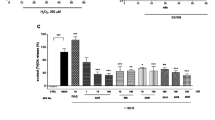Abstract
In Parkinson's disease and other neurodegenerative diseases, (- )deprenyl, an inhibitor of type B monoamine oxidase (MAO-B), has been proposed to protect or rescue declining neurons. However, clinical trials failed to confirm the neuroprotection, even though in vivo and in vitro studies suggested the possibilities. This paper describes the activities of propargylamine MAO-B inhibitors against apoptosis induced by an endogenous selective dopaminergic neurotoxin, N-methyl(R)salsolinol, in dopaminergic SH-SY5Y cells. A series of propargylamines were shown to suppress the apoptotic cascade; preventing collapse of mitochondrial membrane potential, activation of caspase 3 and fragmentation of nucleosomal DNA. Among propargylamines, (R)-N-propargyl1-aminoindan (rasagiline) was the most potent at preventing cell death. Rasagiline also prevented opening of permeability transition pore in insolated mitochondria. These results suggest that rasagiline and other propargylamines may regulate the apoptotic machinery in mitochondria and rescue or protect deteriorated neurons in neurodegenerative disorders.
Similar content being viewed by others
REFERENCES
Akao, Y., Nakagawa, Y., Maruyama, W., Takahashi, T. and Naoi, M. (1999). Apoptosis induced by an endogenous neurotoxin, N-methyl(R)salsolinol, is mediated by activation of caspase 3, Neurosci. Lett. 267, 153–156.
Akao, Y., Maruyama, W., Shimizu, S., Yi, H., et al. (2002). Mitochondrial permeability transition mediates apoptosis induced by N-methyl(R)salsolinol, an endogenous neurotoxin, and is inhibited by Bcl-2 and rasagiline, N-propargyl-1(R)-aminoindan, J. Neurochem. 82, 913–923.
Biangini, G., Frasoldati, A., Fuxe, K., Agnati, L. F., et al. (1993). L-Deprenyl increases GFAP immunoreactivity selectively in activated astrocytes in rat brain, NeuroReport 4, 955–958.
Birkmayer, W., Riederer, P., Youdim, M. B. H., Linauet, W., et al. (1975). The potentiation of the anti-akinetic effect of L-dopa treatment by an inhibitor of MAO-B, L-deprenyl, J. Neural Transm. 30, 303–336.
Bronzetti, E., Felici, L., Ferrante, F., Vasecchi, B., et al. (1992). Effect of ethylcholine mustard aziridinium (AF64A) and on monoamine oxidase-B-inhibitor L-deprenyl on the morphology of rat hippocampus, Int. J. Tissue React. 14, 175–182.
Dipasquale, B., Marini, A. M. and Youle, R. J. (1991). Apoptosis and DNA degradation induced by 1-methyl-4-phenylpyridinium in neurons, Biochem. Biophys. Res. Commun. 181, 1442–1448.
Maruyama, W., Naoi, M., Kasamatsu, T., et al. (1997). An endogenous dopaminergic neurotoxin, N-methyl-(R)salsolinol, induces DNA damage in human dopaminergic neuroblastoma SH-SY5Y cells, J. Neurochem. 69, 322–329.
Maruyama, W., Takahashi, T. and Naoi, M. (1998). (_)-Deprenyl protects human dopaminergic neuroblastoma SH-SY5Y cells from apoptosis induced by peroxynitrite and nitric oxide, J. Neurochem. 70, 2510–2515.
Maruyama, W., Boulton, A. A., Davis, B. A., et al. (2001). Enantio-specific induction of apoptosis by an endogenous neurotoxin, N-methyl(R)salsolinol, in dopaminergic SH-SY5Y cells: suppression of apoptosis by N-(2-heptyl)-N-methylpropargylamine, J. Neural Trans. 108, 11–24.
Maruyama, W., Takahashi, T., Youdim, Y., et al. (2002). The anti-parkinsondrug, rasagiline, prevents apoptotic DNA damage induced by peroxynitrite in human dopaminergic neuroblastoma SH-SY5Y cells, J. Neural. Transm. 109, 467–481.
Mytillineou, C. and Cohen, G. (1985). Deprenyl protects dopaminergic neurons from neurotoxic effects of 1-methyl-4-phenylpyridiniunion, J. Neurochem. 45, 1951–1953.
Mytilineou, C., Leonardi, E. K., Radciliffe, R., et al. (1998). Deprenyl and desmthylselegilineprotect mesencephalic neurons from toxicity induced by glutathione depletion, J. Pharmacol. Exper. Ther. 284, 700–706.
Naoi, M. and Maruyama, W. (1999). N-Methyl(R)salsolinol, a dopamine neurotoxin, in Parkinson's disease, Adv. Neurol. 80, 259–264.
Parkinson Study Group (1989). DATATOP; A multicenter controlled clinical trial in Parkinson's disease, Arch. Neurol. 46, 1052–1064.
Tatton, W. G., Ju, W. J. H., Holland, D. P., et al. (1994). (_)-Deprenyl reduced PC12 cell apoptosis by inducing new protein synthesis, J. Neurochem. 63, 1572– 1575.
Thomas, C. E., Huber, E. W. and Ohlweiler, D. F. (1997). Hydroxyl and peroxy radical trapping by the monoamine oxidase-B inhibitors deprenyl and MDL 72,974A: Implication for protection of biological substrates, Free Radic. Biol. Med. 22, 733–737.
Thompson, C. B. (1995). Apoptosis is the pathogenesis and treatment of disease, Science 267, 1456–1462.
Tipton, K. F. (1994). What is that l-deprenyl (selegiline) might do?, Clin. Pharmacol. Ther. 566, 781–796.
Tsujimoto, Y. and Shimizu, S. (2000). Bcl-2 family: Life–death switch, FEBS Lett. 466, 6–10.
Yu, P. H., Davis, B. A., Fang, J., et al. (1994). Neuroprotective effects of some monoamine oxidase-B inhibitors against DSP-4-induced noradrenaline depletion in the mouse hippocampus, J. Neurochem. 63, 1820– 1828.
Ziv, I., Melamed, E., Nardi, N., et al. (1994). Dopamine induces apoptosis-like cell death in cultured chick sympathetic neurons-a possible novel pathogenic mechanism in Parkinson's disease, Neurosci. Lett. 170, 136–140.
Rights and permissions
About this article
Cite this article
Naoi, M., Maruyama, W., Youdim, M.B.H. et al. Anti-apoptotic function of propargylamine inhibitors of type-B monoamine oxidase. Inflammopharmacology 11, 175–181 (2003). https://doi.org/10.1163/156856003765764344
Issue Date:
DOI: https://doi.org/10.1163/156856003765764344




